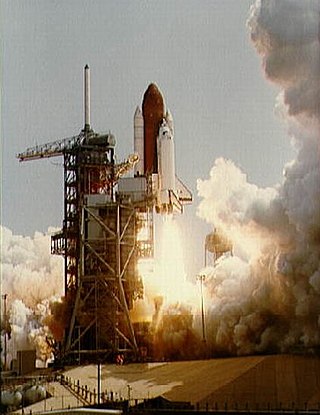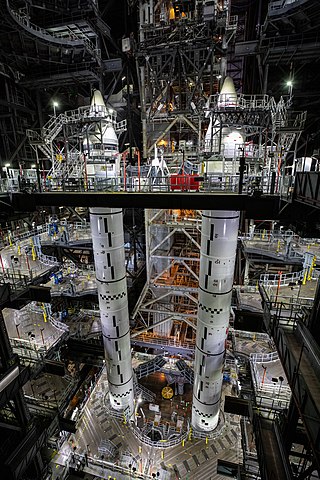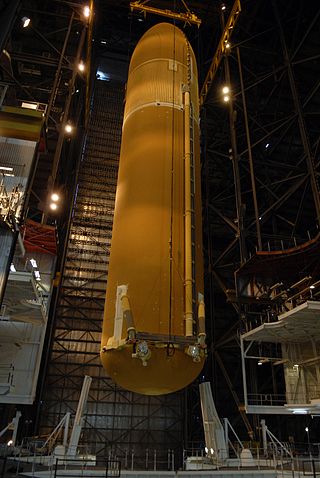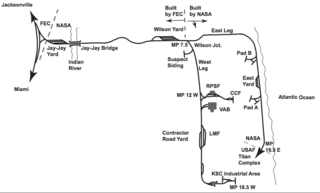
The Space Shuttle is a retired, partially reusable low Earth orbital spacecraft system operated from 1981 to 2011 by the U.S. National Aeronautics and Space Administration (NASA) as part of the Space Shuttle program. Its official program name was Space Transportation System (STS), taken from a 1969 plan for a system of reusable spacecraft where it was the only item funded for development.

STS-4 was the fourth NASA Space Shuttle mission, and also the fourth for Space Shuttle Columbia. Crewed by Ken Mattingly and Henry Hartsfield, the mission launched on June 27, 1982, and landed a week later on July 4, 1982. Due to parachute malfunctions, the SRBs were not recovered.

A booster rocket is either the first stage of a multistage launch vehicle, or else a shorter-burning rocket used in parallel with longer-burning sustainer rockets to augment the space vehicle's takeoff thrust and payload capability. Boosters are traditionally necessary to launch spacecraft into low Earth orbit, and are especially important for a space vehicle to go beyond Earth orbit. The booster is dropped to fall back to Earth once its fuel is expended, a point known as booster engine cut-off (BECO).

On January 28, 1986, the Space Shuttle Challenger broke apart 73 seconds into its flight, killing all seven crew members aboard. The spacecraft disintegrated 46,000 feet (14 km) above the Atlantic Ocean, off the coast of Cape Canaveral, Florida, at 11:39 a.m. EST. It was the first fatal accident involving an American spacecraft while in flight.

STS-51-C was the 15th flight of NASA's Space Shuttle program, and the third flight of Space Shuttle Discovery. It launched on January 24, 1985, and made the fourth shuttle landing at Kennedy Space Center, Florida, on January 27, 1985. STS-51-C was the first shuttle mission to deploy a dedicated United States Department of Defense (DoD) payload, and consequently many mission details remain classified.

The Space Shuttle Solid Rocket Booster (SRB) was the first solid-propellant rocket to be used for primary propulsion on a vehicle used for human spaceflight. A pair of these provided 85% of the Space Shuttle's thrust at liftoff and for the first two minutes of ascent. After burnout, they were jettisoned and parachuted into the Atlantic Ocean where they were recovered, examined, refurbished, and reused.

A solid rocket booster (SRB) is a large solid propellant motor used to provide thrust in spacecraft launches from initial launch through the first ascent. Many launch vehicles, including the Atlas V, SLS and space shuttle, have used SRBs to give launch vehicles much of the thrust required to place the vehicle into orbit. The space shuttle used two space shuttle SRBs, which were the largest solid propellant motors ever built and the first designed for recovery and reuse. The propellant for each solid rocket motor on the space shuttle weighed approximately 500,000 kilograms.

The Space Shuttle Pathfinder is a Space Shuttle test simulator made of steel and wood. Constructed by NASA in 1977 as an unnamed facilities test article, it was purchased in the early 1980s by the America-Japan Society, Inc. which had it refurbished, named it, and placed it on display in the Great Space Shuttle Exhibition in Tokyo. The mockup was later returned to the United States and placed on permanent display at the U.S. Space & Rocket Center in Huntsville, Alabama, in May 1988.

The Space Shuttle external tank (ET) was the component of the Space Shuttle launch vehicle that contained the liquid hydrogen fuel and liquid oxygen oxidizer. During lift-off and ascent it supplied the fuel and oxidizer under pressure to the three RS-25 main engines in the orbiter. The ET was jettisoned just over 10 seconds after main engine cut-off (MECO) and it re-entered the Earth's atmosphere. Unlike the Solid Rocket Boosters, external tanks were not re-used. They broke up before impact in the Indian Ocean, away from shipping lanes and were not recovered.

Shuttle-derived vehicles (SDV) are space launch vehicles and spacecraft that use components, technology, and infrastructure originally developed for the Space Shuttle program.

The Exploration Systems Architecture Study (ESAS) is the official title of a large-scale, system level study released by the National Aeronautics and Space Administration (NASA) in November 2005 of his goal of returning astronauts to the Moon and eventually Mars—known as the Vision for Space Exploration. The Constellation Program was cancelled in 2010 by the Obama Administration and replaced with the Space Launch System, later renamed as the Artemis Program in 2017 under the Trump Administration.

STS-51-L was the 25th mission of NASA's Space Shuttle program and the final flight of Space Shuttle Challenger.

The Ares V was the planned cargo launch component of the cancelled NASA Constellation program, which was to have replaced the Space Shuttle after its retirement in 2011. Ares V was also planned to carry supplies for a human presence on Mars. Ares V and the smaller Ares I were named after Ares, the Greek god of war.

The booster separation motors or BSMs on the Space Shuttle were relatively small rocket motors that separated the reusable solid rocket boosters (SRB) from the orbiter after SRB burnout. Eight booster separation motors were attached to each of the shuttle's two reusable solid rocket boosters, four on the forward frustum and four on the aft skirt.
The frangible nut is a component used in many industries, but most commonly by NASA, to sever mechanical connections. It is, by definition, an explosively-splittable nut. The bolt remains intact while the nut itself is split into two or more parts.

The NASA recovery ships are two ships, the MV Liberty Star and the MV Freedom Star, that were tasked with retrieving spent Solid Rocket Boosters (SRBs) following the launch of Space Shuttle missions. Although owned by NASA, the ships were operated by Space Flight Operations contractor United Space Alliance. Following the end of the Space Shuttle program, and therefore booster recovery, NASA transferred both vessels to the Department of Transportation.

The NASA Railroad is a Class III industrial short-line railroad at the Kennedy Space Center in Cape Canaveral, Florida. The railroad consists of 38 miles (61 km) of track connecting the mainline of the Florida East Coast Railway and trackage at the Cape Canaveral Space Force Station. NASA uses the railroad to deliver large or bulk materials to support its operations, particularly solid rocket boosters and chemicals such as helium and oxygen for rocket fuel.

DIRECT was a late-2000s proposed alternative super heavy lift launch vehicle architecture supporting NASA's Vision for Space Exploration that would replace the space agency's planned Ares I and Ares V rockets with a family of Shuttle-Derived Launch Vehicles named "Jupiter". It was intended to be the alternative to the Ares I and Ares V rockets which were under development for the Constellation program, intended to develop the Orion spacecraft for use in Earth orbit, the Moon, and Mars.

OmegA was a medium-lift to heavy-lift launch vehicle concept that spent several years in development by Northrop Grumman during 2016–2020, with that development substantially funded by the U.S. government. OmegA was intended for launching U.S. national security satellites, as part of the U.S. Department of the Air Force National Security Space Launch (NSSL) replacement program.

During the lifetime of the Space Shuttle, Rockwell International and many other organizations studied various Space Shuttle designs. These involved different ways of increasing cargo and crew capacity, as well as investigating further reusability. A large focus of these designs were related to developing new shuttle boosters and improvements to the central tank, but also looked to expand NASA's ability to launch deep space missions and build modular space stations. Many of these concepts and studies would shape the concepts and programs of the 2000s such as the Constellation, Orbital Space Plane Program, and Artemis program.



















